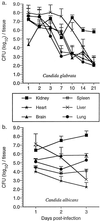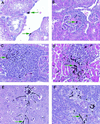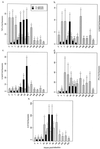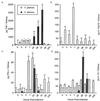Comparison of pathogenesis and host immune responses to Candida glabrata and Candida albicans in systemically infected immunocompetent mice
- PMID: 11447185
- PMCID: PMC98599
- DOI: 10.1128/IAI.69.8.5046-5055.2001
Comparison of pathogenesis and host immune responses to Candida glabrata and Candida albicans in systemically infected immunocompetent mice
Abstract
Cytokine-mediated host defense against Candida glabrata infection was compared to that against C. albicans, using immunocompetent murine models of systemic candidiasis. The pathogenesis of infection was evaluated morphologically and by culture of target organs, while the kinetics of induction of cytokine mRNAs and corresponding proteins were determined in kidneys by real-time reverse transcription-PCR and cytokine-specific murine enzyme-linked immunosorbent assays, respectively. Systemic infection with C. glabrata resulted in a chronic, nonfatal infection with recovery of organisms from kidneys, while intravenous inoculation with C. albicans resulted in rapid mortality with logarithmic growth of organisms in kidneys and recovery of C. albicans from the spleen, liver, and lungs. Survival of C. glabrata-infected mice was associated with rapid induction of mRNAs and corresponding immunoreactive proteins for the proinflammatory cytokines tumor necrosis factor alpha (TNF-alpha), interleukin-12 (IL-12), and gamma interferon (IFN-gamma) and the lack of induction of protein for the anti-inflammatory cytokine IL-10. In contrast, mortality in C. albicans-infected mice was associated with induction of mRNA and corresponding protein for IL-10 but delayed (i.e., TNF-alpha) or absent (i.e., IL-12 and IFN-gamma) induction of immunoreactive proinflammatory cytokines. Mice were subsequently treated with cytokine-specific neutralizing monoclonal antibodies (MAbs) to TNF-alpha, IL-12, or IFN-gamma, and the effect on growth of C. glabrata in kidneys was assessed. Neutralization of endogenous TNF-alpha resulted in a significant increase in C. glabrata organisms compared to similarly infected mice administered an isotype-matched control MAb, while neutralization of endogenous IL-12 or IFN-gamma had no significant effect on C. glabrata replication. These results demonstrate that in response to intravenous inoculation of C. glabrata, immunocompetent mice develop chronic nonfatal renal infections which are associated with rapid induction of the proinflammatory cytokines TNF-alpha, IL-12, and IFN-gamma. Furthermore, TNF-alpha plays a key role in host defense against systemic candidiasis caused by either C. glabrata or C. albicans, as the absence of endogenous TNF-alpha activity was associated with enhanced tissue burden in both infection models.
Figures





 ), TNF-α (
), TNF-α ( ), anti-IL-12 (
), anti-IL-12 ( ), or anti-IFN-γ (
), or anti-IFN-γ ( ) MAb (1 mg/mouse intraperitoneally) 1 day prior to infection with C. glabrata. At 3, 5, and 7 days p.i., mice were euthanized, kidneys were excised and homogenized, and growth of C. glabrata was quantified by culture of kidney homogenates. Results represent the pooled mean ± SEM of two separate experiments, 10 to 15 animals per treatment group. *, significantly greater than similarly infected mice administered control MAb, P < 0.05.
) MAb (1 mg/mouse intraperitoneally) 1 day prior to infection with C. glabrata. At 3, 5, and 7 days p.i., mice were euthanized, kidneys were excised and homogenized, and growth of C. glabrata was quantified by culture of kidney homogenates. Results represent the pooled mean ± SEM of two separate experiments, 10 to 15 animals per treatment group. *, significantly greater than similarly infected mice administered control MAb, P < 0.05.Similar articles
-
Endogenous interleukin (IL)-1 alpha and IL-1 beta are crucial for host defense against disseminated candidiasis.J Infect Dis. 2006 May 15;193(10):1419-26. doi: 10.1086/503363. Epub 2006 Apr 4. J Infect Dis. 2006. PMID: 16619190
-
The role of endogenous interleukin (IL)-18, IL-12, IL-1beta, and tumor necrosis factor-alpha in the production of interferon-gamma induced by Candida albicans in human whole-blood cultures.J Infect Dis. 2002 Apr 1;185(7):963-70. doi: 10.1086/339410. Epub 2002 Mar 11. J Infect Dis. 2002. PMID: 11920321
-
The role of recombinant murine IL-12 and IFN-gamma in the pathogenesis of a murine systemic Candida albicans infection.J Immunol. 1998 Jan 1;160(1):284-92. J Immunol. 1998. PMID: 9551982
-
Initiation of T-helper cell immunity to Candida albicans by IL-12: the role of neutrophils.Chem Immunol. 1997;68:110-35. doi: 10.1159/000058688. Chem Immunol. 1997. PMID: 9329219 Review.
-
Candida glabrata: review of epidemiology, pathogenesis, and clinical disease with comparison to C. albicans.Clin Microbiol Rev. 1999 Jan;12(1):80-96. doi: 10.1128/CMR.12.1.80. Clin Microbiol Rev. 1999. PMID: 9880475 Free PMC article. Review.
Cited by
-
Survival Strategies of Pathogenic Candida Species in Human Blood Show Independent and Specific Adaptations.mBio. 2020 Oct 6;11(5):e02435-20. doi: 10.1128/mBio.02435-20. mBio. 2020. PMID: 33024045 Free PMC article.
-
Anidulafungin pharmacokinetics and microbial response in neutropenic mice with disseminated candidiasis.Antimicrob Agents Chemother. 2006 Nov;50(11):3695-700. doi: 10.1128/AAC.00507-06. Epub 2006 Sep 5. Antimicrob Agents Chemother. 2006. PMID: 16954319 Free PMC article.
-
Immune Protection against Lethal Fungal-Bacterial Intra-Abdominal Infections.mBio. 2018 Jan 16;9(1):e01472-17. doi: 10.1128/mBio.01472-17. mBio. 2018. PMID: 29339423 Free PMC article.
-
Using Bioluminescence to Image Candida glabrata Urinary Tract Infections in Mice.Methods Mol Biol. 2023;2658:239-247. doi: 10.1007/978-1-0716-3155-3_17. Methods Mol Biol. 2023. PMID: 37024707
-
Vav Proteins Are Key Regulators of Card9 Signaling for Innate Antifungal Immunity.Cell Rep. 2016 Dec 6;17(10):2572-2583. doi: 10.1016/j.celrep.2016.11.018. Cell Rep. 2016. PMID: 27926862 Free PMC article.
References
-
- Atkinson B A, Bouthet C, Bocanegra R, Correa A, Luther M F, Graybill J R. Comparison of fluconazole, amphotericin B, and flucytosine in treatment of a murine model of disseminated infection with Candida glabrata in immunocompromised mice. J Antimicrob Chemother. 1995;35:631–640. - PubMed
-
- Barret-Bee K, Hayes Y, Wilson R G, Ryley J F. A comparison of phospholipase activity, cellular adherence and pathogenicity of yeasts. J Gen Microbiol. 1985;131:1217–1221. - PubMed
-
- Bennet D E, McCreary C E, Coleman D C. Genetic characterization of a phospholipase C gene from Candida albicans: presence of homologous sequences in Candida species other than Candida albicans. Microbiology. 1998;144:55–72. - PubMed
-
- Blasti E, Manuela P, Pitzurra L, Bartoli A, Bistoni F. Heterogeneous secretory responses of phagocytes from different anatomical districts to the dimorphic fungus Candida albicans. Cell Immunol. 1994;153:239–247. - PubMed
Publication types
MeSH terms
Substances
LinkOut - more resources
Full Text Sources
Other Literature Sources
Medical

